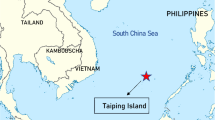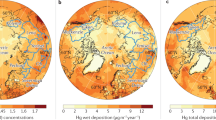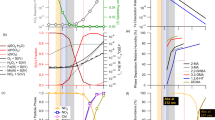Abstract
Mercury contamination affects many aquatic ecosystems1. The atmosphere is the main transport route for this toxicant2. According to aircraft measurements, the upper troposphere and lower stratosphere are depleted in gaseous elemental mercury3,4 but enriched in oxidized, particle-bound mercury5,6. It is therefore assumed that mercury is oxidized in the stratosphere, and then incorporated into stratospheric aerosols6. However, direct evidence for mercury oxidation in the stratosphere is missing. Here, we present simultaneous measurements of elemental and oxidized mercury concentrations in air of stratospheric origin, collected during an aircraft campaign over North America and Europe in 2010. We show that levels of oxidized mercury are strongly correlated with tracers of stratospheric air. Concentrations of total and elemental mercury, in contrast, are negatively correlated with these tracers. Together, the findings indicate that elemental mercury is oxidized in stratospheric air masses. We develop a numerical model of atmospheric mercury, based on the assumption that mercury is oxidized in the upper troposphere and lower stratosphere. The resultant vertical profiles—which depict a rapid decline in mercury concentrations with increasing stratospheric height—resemble those seen in other studies, and indicate that mercury has a relatively short stratospheric lifetime. We suggest that following oxidation, mercury is removed from the stratosphere by sedimentation and entrainment processes common to all stratospheric particles.
This is a preview of subscription content, access via your institution
Access options
Subscribe to this journal
Receive 12 print issues and online access
$259.00 per year
only $21.58 per issue
Buy this article
- Purchase on Springer Link
- Instant access to full article PDF
Prices may be subject to local taxes which are calculated during checkout




Similar content being viewed by others
References
Selin, N. E. Global biogeochemical cycling of mercury: A review. Annu. Rev. Environ. Res. 34, 43–63 (2009).
Fitzgerald, W. F., Engstrom, D. R., Mason, R. P. & Nater, E. A. The case for atmospheric mercury contamination in remote areas. Environ. Sci. Technol. 32, 1–7 (1998).
Talbot, R., Mao, H., Scheuer, E., Dibb, J. & Avery, M. Total depletion of Hg in the upper troposphere–lower stratosphere. Geophys. Res. Lett. 34, L23804 (2007).
Slemr, F. et al. Gaseous mercury distribution in the upper troposphere and lower stratosphere observed onboard the CARIBIC passenger aircraft. Atmos. Chem. Phys. 9, 1957–1969 (2009).
Murphy, D., Thomson, D. & Mahoney, M. In situ measurements of organics, meteoritic material, mercury, and other elements in aerosols at 5 to 19 km. Science 282, 1664–1669 (1998).
Murphy, D., Hudson, P., Thomson, D., Sheridan, P. & Wilson, J. Observations of mercury-containing aerosols. Environ. Sci. Technol. 40, 3163–3167 (2006).
Swartzendruber, P. C. et al. Observations of reactive gaseous mercury in the free troposphere at the Mt. Bachelor Observatory. J. Geophys. Res. 111, D24301 (2006).
Swartzendruber, P. C., Jaffe, D. A. & Finley, B. Development and first results of an aircraft-based, high time resolution technique for gaseous elemental and reactive (oxidized) gaseous mercury. Environ. Sci. Technol. 43, 7484–7489 (2009).
Fain, X., Obrist, D., Hallar, A. G., McCubbin, I. & Rahn, T. High levels of reactive gaseous mercury observed at a high elevation research laboratory in the Rocky Mountains. Atmos. Chem. Phys. 9, 8049–8060 (2009).
Rutter, A. P. & Schauer, J. J. The effect of temperature on the gas-particle partitioning of reactive mercury in atmospheric aerosols. Atmos. Environ. 41, 8647–8657 (2007).
Mao, H. et al. Arctic mercury depletion and its quantitative link with halogens. J. Atmos. Chem. 65, 1–26 (2010).
Swartzendruber, P. C. et al. Vertical distribution of mercury, CO, ozone, and aerosol scattering coefficient in the Pacific Northwest during the spring 2006 INTEX-B campaign. J. Geophys. Res. 113, D10305 (2008).
Holmes, C. D. et al. Global atmospheric model for mercury including oxidation by bromine atoms. Atmos. Chem. Phys. 10, 12037–12057 (2010).
Murphy, D. & Thomson, D. Halogen ions and NO in the mass spectra of aerosols in the upper troposphere and lower stratosphere. Geophys. Res. Lett. 27, 3217–3220 (2000).
Dorf, M. et al. Bromine in the tropical troposphere and stratosphere as derived from balloon-borne BrO observations. Atmos. Chem. Phys. 8, 7265–7271 (2008).
Skov, H. et al. Fate of elemental mercury in the Arctic during atmospheric mercury depletion episodes and the load of atmospheric mercury to the Arctic. Environ. Sci. Technol. 38, 2373–2382 (2004).
Rasch, P. J. et al. An overview of geoengineering of climate using stratospheric sulphate aerosols. Phil. Trans. R. Soc. A 366, 4007–4037 (2008).
Menzies, R. T. & Tratt, D. M. Evidence of seasonally dependent stratosphere–troposphere exchange and purging of lower stratospheric aerosol from a multiyear lidar data set. J. Geophys. Res. 100, 3139–3148 (1995).
Zhao, J., Turco, R. P. & Toon, O. B. A model simulation of Pinatubo volcanic aerosols in the stratosphere. J. Geophys. Res. 100, 7315–7328 (1995).
Notholt, J. et al. Enhanced upper tropical tropospheric COS: Impact on the stratospheric aerosol layer. Science 300, 307–310 (2003).
Wilson, J. C. et al. Steady-state aerosol distributions in the extra-tropical, lower stratosphere and the processes that maintain them. Atmos. Chem. Phys. 8, 6617–6626 (2008).
Barkley, M. P., Palmer, P. I., Boone, C. D., Bernath, P. F. & Suntharalingam, P. Global distributions of carbonyl sulfide in the upper troposphere and stratosphere. Geophys. Res. Lett. 35, L14810 (2008).
Selin, N. E. & Jacob, D. J. Seasonal and spatial patterns of mercury wet deposition in the United States: Constraints on the contribution from North American anthropogenic sources. Atmos. Environ. 42, 5193–5204 (2008).
Weiss-Penzias, P., Gustin, M. S. & Lyman, S. N. Observations of speciated atmospheric mercury at three sites in Nevada: Evidence for a free tropospheric source of reactive gaseous mercury. J. Geophys. Res. 114, D14302 (2009).
Dibb, J. E. et al. Estimation of stratospheric input to the Arctic troposphere: 7Be and 10Be in aerosols at Alert, Canada. J. Geophys. Res. 99, 12855–12864 (1994).
Zanis, P. et al. An estimate of the impact of stratosphere-to-troposphere transport (STT) on the lower free tropospheric ozone over the Alps using 10Be and 7Be measurements. J. Geophys. Res. 108, 8520–8529 (2003).
Seo, K. & Bowman, K. P. Lagrangian estimate of global stratosphere–troposphere mass exchange. J. Geophys. Res. 107, 4555–4563 (2002).
Ridley, B. A., Grahek, F. E. & Walega, J. G. A small high-sensitivity, medium-response ozone detector suitable for measurements from light aircraft. J. Atmos. Oceanic Technol. 9, 142–148 (1992).
Gassó, S. & Hegg, D. A. Comparison of columnar aerosol optical properties measured by the MODIS airborne simulator with in situ measurements: A case study. Remote Sens. Environ. 66, 138–152 (1998).
Acknowledgements
This study was financially supported by the US National Science Foundation. We thank the CARIBIC team (especially F. Slemr and R. Ebinghaus) for providing us with CARIBIC data (www.caribic-atmospheric.com). We thank R. Talbot at the University of Houston for access to data from INTEX-B and ARCTAS. We are grateful for the efforts of numerous technicians, engineers and scientists at NCAR’s Research Aviation Facility who were essential to the success of this work.
Author information
Authors and Affiliations
Contributions
S.N.L. participated in study design, collected and analysed data and is the primary author of the manuscript. D.A.J. led the study and contributed substantially to all aspects of it, including manuscript preparation.
Corresponding author
Ethics declarations
Competing interests
The authors declare no competing financial interests.
Supplementary information
Supplementary Information
Supplementary Information (PDF 949 kb)
Rights and permissions
About this article
Cite this article
Lyman, S., Jaffe, D. Formation and fate of oxidized mercury in the upper troposphere and lower stratosphere. Nature Geosci 5, 114–117 (2012). https://doi.org/10.1038/ngeo1353
Received:
Accepted:
Published:
Issue Date:
DOI: https://doi.org/10.1038/ngeo1353
This article is cited by
-
Total mercury in soil and leachate from municipal solid waste dumping grounds in Mumbai, India
Environmental Earth Sciences (2022)
-
Resolving a paradox—high mercury deposition, but low bioaccumulation in northeastern Puerto Rico
Ecotoxicology (2020)
-
Adaption and use of a quadcopter for targeted sampling of gaseous mercury in the atmosphere
Environmental Science and Pollution Research (2018)
-
A review of global environmental mercury processes in response to human and natural perturbations: Changes of emissions, climate, and land use
Ambio (2018)
-
Tundra uptake of atmospheric elemental mercury drives Arctic mercury pollution
Nature (2017)



